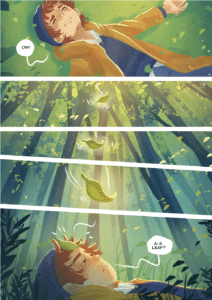What to Have In Your Graphic Novel Illustration Portfolio
Published on 15/06/2023Illustrations by Astound US Inc. illustrators Alessia Trunfio, Alex Lopez, Fran Bueno, Karen De La Vega, Markia Jenai, and Pedro Rodriguez
What to Have In Your Graphic Novel Illustration Portfolio
Teacher: Aurora Barlam, Senior Agent, Astound US Inc
We all know graphic novels are a growing field! Despite that, comics can still be a tough industry to break into. In order to make your portfolio stand out, here are my top tips on what to have in your graphic novel illustration portfolio.
I suggest staying competitive by including both inked black and white art and fully colored art in your portfolio (even though you can work with inkers and colorists on published books). Your skills with both line quality and color palettes will definitely impress editors (pro tip about color palettes: carefully choose how much purple you use, since this color is often overused in comic book art). You can also show character designs in your portfolio, along with fan art of licensed characters if you dream of illustrating your favorite superheroes, TV shows, movies, and toy franchises. The absolute most important thing to include in your portfolio is sequential art.

Sequential art means an illustration that uses multiple panels to tell a story. The term covers everything from newspaper comic strips to elaborate spreads in graphic novel volumes. Graphic novel pages tend to be around 2:3 dimensions and often have 3-9 panels a page (depending on the age range the story is targeted to: less panels for younger audiences, more for older audiences). When designing a composition for a page, consider how to show the action going from one panel to the next. Think of each panel like a frame in a movie. For example, in a story where a kid kicks a ball, you draw the kid and ball in one panel, the foot hitting the ball in the next, and then show where the ball goes. With such a simple prompt, you can probably imagine so many creative ways to visually tell this tale.
When looking at your sequential art, editors will ask themselves:
- Does the action from one panel to the next make sense? For example, if in one panel the ball is on the ground, and then in the next, the ball is in the air, then you need a panel in between where that ball is kicked into the air.
- Is every action explained in the story? If the next page has an adult holding the ball, then where did they pick it up?
- How are you leading the eye through the panels? Draw the reader’s attention to the most important characters and objects within panels, then direct their eyes from one panel to the next in the right order. Also, watch out for tangents that might confuse the reader (for example, straight lines from the top to the bottom of panels can be confused for panel borders).
- Is it dynamic? Try to make a visually interesting composition that your readers will want to explore. Detailed, well-designed backgrounds often separate amateur art from professional art. When everything else is beautifully detailed, you can use more simple panels for visual impact, like a close-up shot in a movie.
Make sure your art answers all these questions! Once you master the basics, there are lots of fun ways to bend the rules, like showing characters fall out of panels or getting rid of the panel borders altogether. After putting this insider knowledge into practice, your portfolio will be sure to impress.
For more free tips for how to improve your illustration portfolio, subscribe to our ITSme Learning Newsletter!
Other News
What Happens in an ITSme Mentorship? A Week-by-Week Breakdown
Imagine having a guide who not only understands the creative path an individual wants to walk, but also has the knowledge and tools to help them get there – successfully. That’s the core of the ITSme Learning Mentorship. Whether someone is a student, a young professional at the beginning of their career, or an artist…
Announcing Our Very First Picture Book Course!
We are extremely excited to announce our first picture book class and mentorship program, in a collaboration between Caroline Wakeman Literary Agency and multi-talented author-illustrator Sally Anne Garland. Your Picture Book Journey: How to Write and Illustrate Your Own Picture Book is a 12-week course for writers, illustrators, and visual storytellers ready to bring their…
Why Every Illustrator Portfolio Needs a Stand-Out Character (Yes, Even Yours)
When you’re thinking about our favourite stories as a child, we often think about the narrative, the themes, perhaps a particular quote that stood out, but the most memorable elements are always the characters. The reason the characters always stay in our minds is because they are the gateway to the narrative, and all of…
Trend Watch: YA Illustrated Covers
Over the past few years, illustrated covers have become a defining visual language in the Young Adult (YA) and New Adult (NA) book market. And no, this isn’t just a passing trend—it’s a design evolution powered by the viral force of #BookTok, #bookgirlies, and a growing appetite for genre-fluid storytelling. Hear what’s driving the…
Trend Watch: The Graphic Novel Boom
Every week we’ll be featuring a new article over on LinkedIn, in our new trend watch series! Graphic novels are having a moment—and it’s no passing trend. From classrooms to bestseller lists, graphic novels are dominating shelves and reading time across all ages. What was once seen as a niche format with a distinct, heavy-lined “comic book”…
Bologna 2025: A Week of Connection
By: Vicky Patoulioti, Talent Source Manager, ITSme This year’s Bologna Children’s Book Fair was one to remember. From early mornings to late evenings, our team Vicky, Bhavi, Ed, and Emily — were on the ground offering free portfolio reviews to artists from all over the world. Mornings kicked off with pre-scheduled reviews, while in the…




